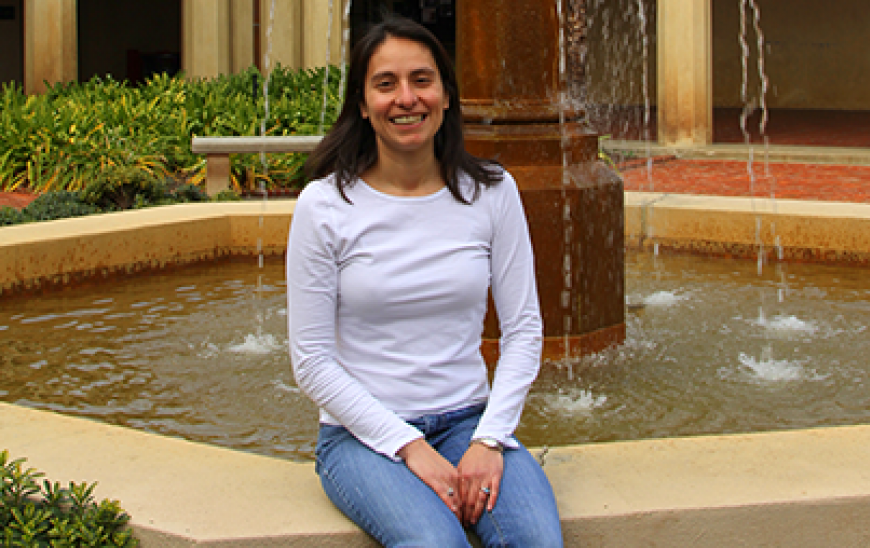The Stanford School of Earth, Energy & Environmental Sciences is now part of the Stanford Doerr School of Sustainability.
This page is currently being maintained for archival purposes only. For the latest information, please visit us here.
Paula Welander bridges microbiology and geology
Interdisciplinary scientist studies geologically relevant lipids called hopanoids that are produced by bacteria.
By
Louis Bergeron
October 9, 2013
Ben Shaw

Paula Welander
Paula Welander likes to point out that the majority of life, for the billions of years that Earth has been habitable, has been microbial, and that for the first two billion years, bacteria and other single-celled organisms were the only game on the planet. But unlike dinosaurs, microbes don’t leave bones that can fossilize, making it challenging for geologists to study what life or the environment were like back then. Which is where she comes in.
“I study molecules made by living bacteria that geologists are actually able to find in rocks that are millions, and potentially billions, of years old,” said Welander, an assistant professor of Environmental Earth System Science who works in the field of geobiology. She investigates how bacteria make those molecules today and under what conditions, which can guide geologists in inferring what the presence of those “biomarker” molecules indicates about environmental conditions in the past.
Welander arrived at Stanford last year, following a three-year postdoc in the Earth sciences at the Massachusetts Institute of Technology. Having previously been affiliated with biology or microbiology departments, her stint in Earth sciences was something of an eye-opener.
“I realized how my work can impact the field of geobiology a lot more in an Earth sciences department than it might if I were in a biology department,” she said.
At Stanford, the organism Welander is studying consumes oxygen and methane for sustenance and produces lipid molecules known as hopanoids. These hopanoids are found in the rock record and one study found them in rocks thought formed in an ocean about 1.6 billion years ago. The presence of hopanoids indicates that there may have been a methane cycle in that ocean.
“Geologists don’t base their whole interpretation of these ancient rocks on this one molecule that they find, but it’s a part of the picture,” Welander said. “It has been a very powerful tool in general, in terms of helping researchers show that certain microbial life was present at whatever time they are investigating, no matter how old a given rock is.”
To gain a better understanding of the biosynthesis and function of hopanoids, Welander combines bioinformatics with bacterial genetics and microbial physiology. Using these techniques, she identified the genes and proteins required for producing hopanoids in the cell. This was a significant breakthrough as it allows for more detailed molecular studies on hopanoids. For example, she has developed genetic techniques that allow her to delete the hopanoid genes in her model bacterium. This resulted in a bacterial strain that is no longer able to produce hopanoids. By comparing the physiology of the new mutant strain to the original bacterial strain, Welander can assess how the loss of hopanoids causes defects in the cell and ultimately understand what the cellular function of hopanoids may be. She hopes that this information will in turn help geobiologists better understand the occurrence of hopanoid signatures in the rock record.
Early academic interest in microbes
Welander was curious about science at a young age, and as a teenager assumed she would pursue medical school. At Occidental College she majored in sports medicine but felt a pull toward exploratory science. She picked up extracurricular work in a microbiology lab and that, she said, “is where everything came together.”
Fascinated by the speed of microbial systems, Welander loved the fact that a new population of cells could be grown, and an experiment completed, in a matter of days. She was given her own project on which to work: taking genes thought to be necessary for dealing with temperature stress from one organism and putting them into an E. coli strain engineered so that it would not survive heat shock. She proved that the genes she introduced could save the E. coli strain from heat stress.
“I remember seeing that the E. coli strain was living, and thinking, ‘Wow, it worked’,” Welander recalled. At the time she was alone in the lab and said she wanted to shout, “Somebody, look!” From that moment on Welander was hooked on microbial systems. She completed a PhD in microbiology at the University of Illinois before heading to MIT to conduct postdoctoral research.
At Stanford, Welander plans to teach a class focused on microbial physiology and metabolism, as well as one on how molecular biosignatures are used to study microbial systems in both modern and ancient environments. She will no doubt convey her passion for small organisms to her students. “Microbes dominate the world,” Welander said. “They are in every ecosystem. They are in us. They are a ubiquitous part of life on this planet. If you remove them from this planet, you kill the planet. And that’s what drives my research.”
Louis Bergeron is a Bay Area-based freelance writer. Ben Shaw contributed to this article.



